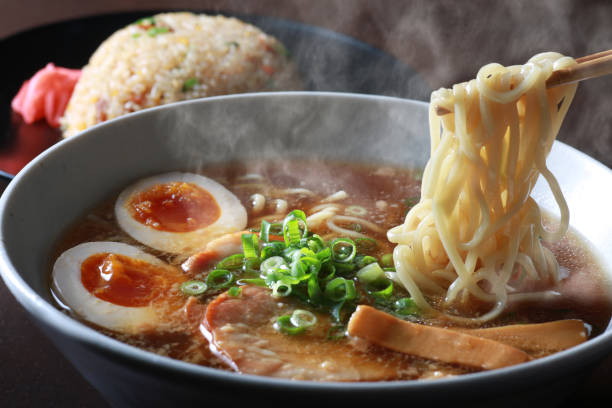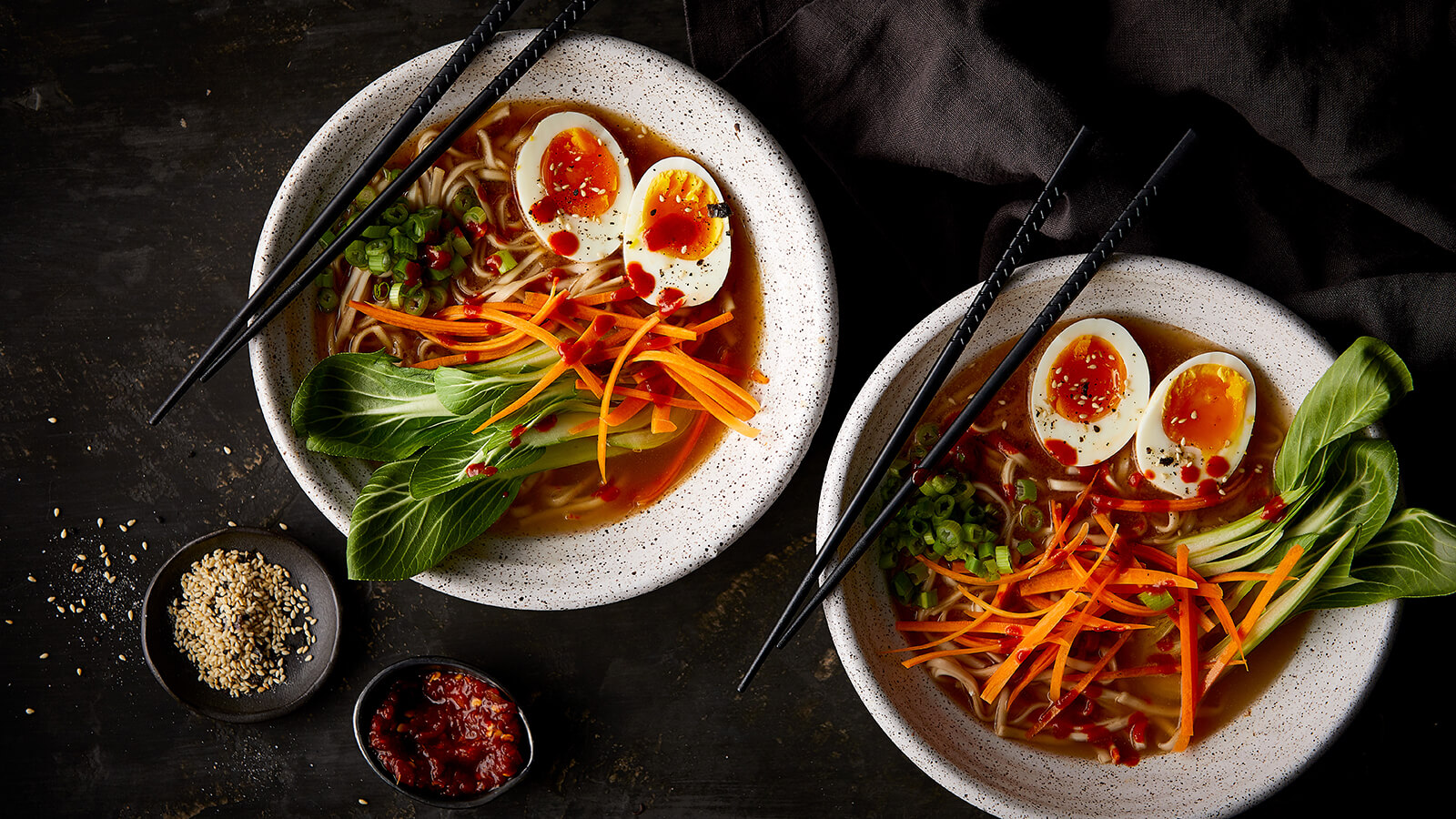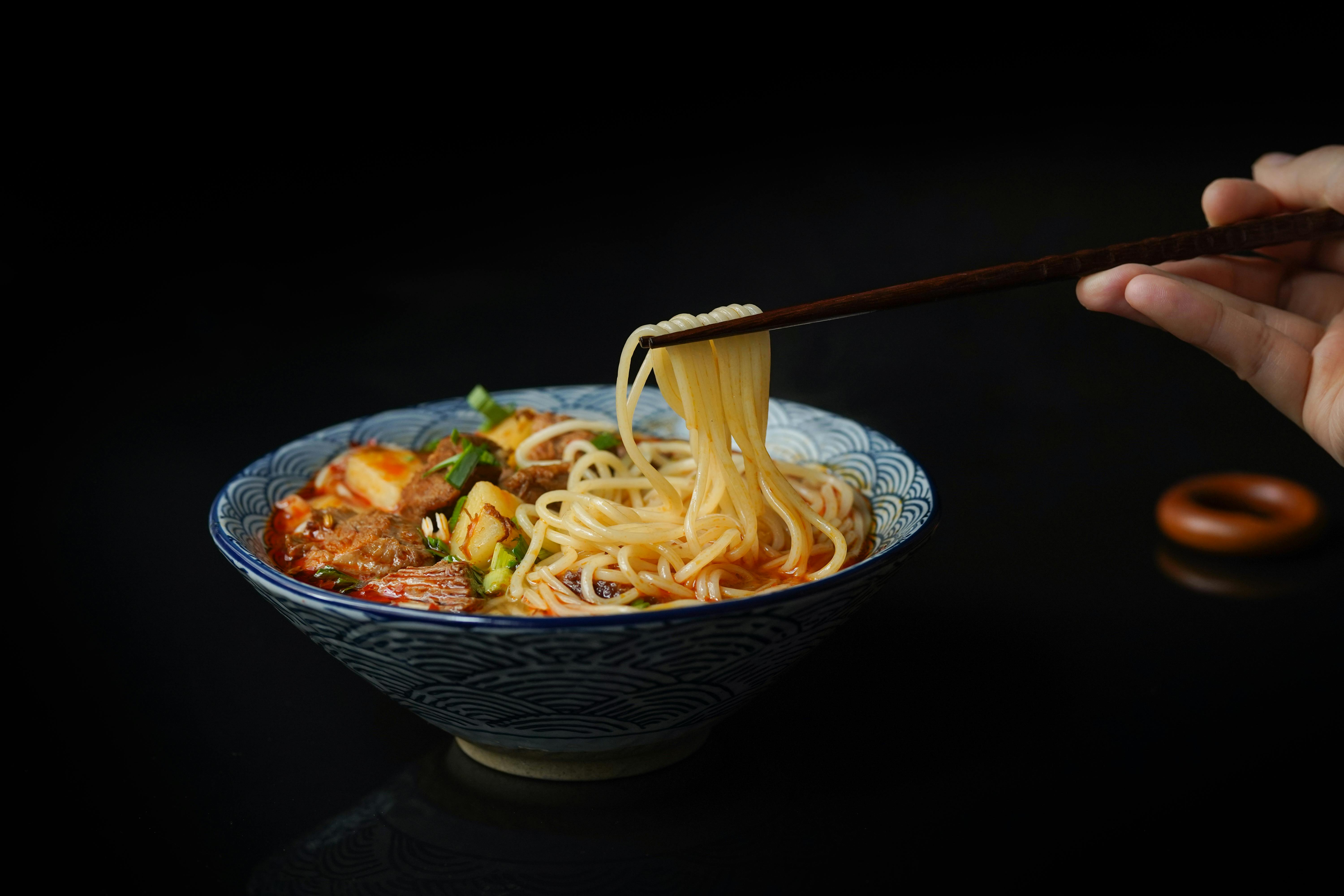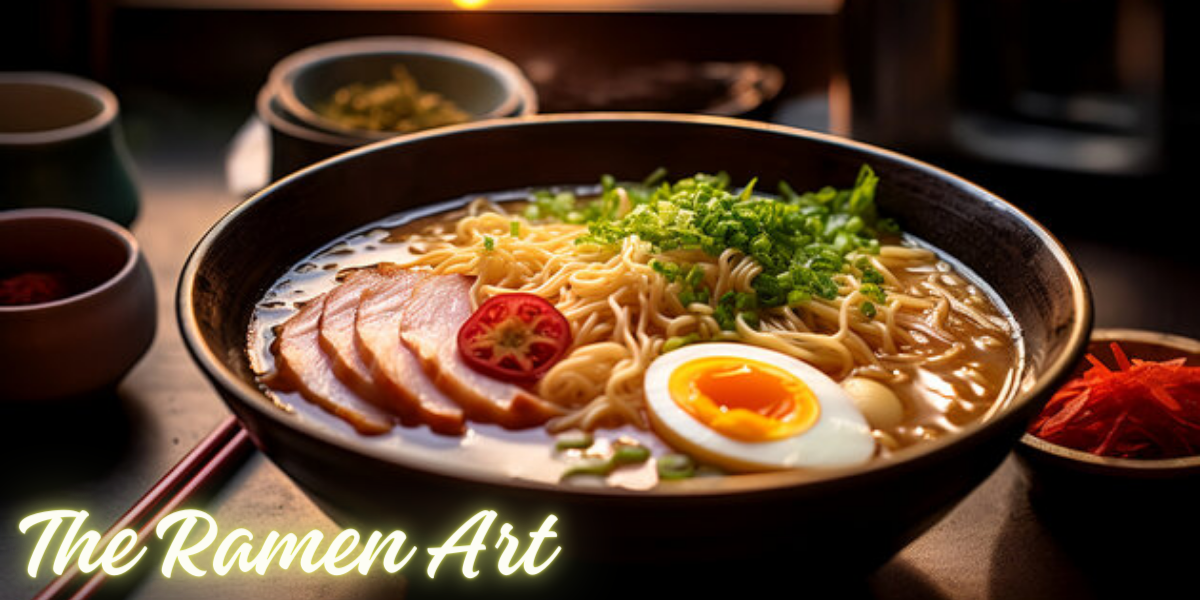Ramen, the soul-warming bowl of noodles, broth, and toppings, holds a special place in Japanese cuisine and culture. From humble beginnings as a Chinese import to its current status as a global comfort food icon, ramen has captivated food enthusiasts worldwide with its rich flavors, diverse styles, and endless creativity. Join us on a culinary odyssey as we explore the art, history, and flavors of ramen.
A Brief History of Ramen:
Ramen’s origins can be traced back to China, where it was introduced as lamian noodles during the late 19th century. Over time, these noodles evolved into the Japanese dish we know today, with regional variations emerging across Japan. Ramen gained popularity as a fast and affordable meal during the post-World War II era and has since become a culinary phenomenon celebrated for its versatility and complexity.
The Elements of Ramen:
At its core, ramen consists of four essential components: noodles, broth, tare (seasoning), and toppings. The noodles, made from wheat flour, water, and alkaline salts, vary in thickness and texture, ranging from thin and curly to thick and chewy. The broth serves as the soul of the ramen, with varieties including tonkotsu (pork bone), shoyu (soy sauce), shio (salt), and miso (fermented soybean paste), each offering a unique flavor profile. Tare, the seasoning base, adds depth and complexity to the broth, while toppings such as chashu pork, soft-boiled egg, bamboo shoots, nori seaweed, and green onions provide texture and contrast.

Regional Ramen Styles:
One of the fascinating aspects of ramen is its regional diversity, with each prefecture in Japan boasting its own distinctive style of ramen. Some notable regional variations include:
- Sapporo Ramen: Known for its hearty miso-based broth and curly noodles, Sapporo ramen is a winter staple in Hokkaido, Japan’s northernmost island.
- Tokyo Ramen: Characterized by its clear and light shoyu broth and straight noodles, Tokyo ramen is a classic representation of the capital city’s culinary identity.
- Hakata Ramen: Hailing from Fukuoka in southern Japan, Hakata ramen features a rich and creamy tonkotsu broth and thin, straight noodles, often served with melt-in-your-mouth pork belly (chashu) and pickled ginger.
Ramen Culture and Etiquette:
In Japan, ramen is more than just a meal—it’s a cultural institution steeped in tradition and etiquette. From the proper way to slurp noodles to the significance of finishing every last drop of broth, there are unwritten rules that govern the ramen dining experience. Slurping noodles not only cools them down but also aerates the broth, enhancing the flavors and aroma. It’s also customary to show appreciation to the chef by finishing every last drop of broth, a sign of respect for their culinary craftsmanship.
Ramen Beyond Borders:
In recent years, ramen has transcended its Japanese origins and gained a global following, with ramen shops popping up in cities around the world. From New York to London to Sydney, ramen enthusiasts can now enjoy authentic bowls of noodles without having to travel to Japan. This global phenomenon has sparked creativity and innovation, leading to fusion ramen styles that blend traditional Japanese flavors with local ingredients and culinary techniques.

A simple recipe for homemade ramen:
Ingredients:
For the broth:
- 4 cups chicken or vegetable broth
- 2 cloves garlic, minced
- 1 tablespoon ginger, grated
- 2 tablespoons soy sauce
- 1 tablespoon mirin (optional)
- Salt and pepper to taste
For the noodles and toppings:
- 2 portions of ramen noodles (fresh or dried)
- 2 soft-boiled eggs
- 2 cups fresh spinach or bok choy, chopped
- 1 cup sliced mushrooms (shiitake, button, or your choice)
- 2 green onions, thinly sliced
- 1 sheet nori seaweed, cut into strips (optional)
- Sesame seeds for garnish (optional)
Instructions:
- Prepare the broth: In a large pot, bring the chicken or vegetable broth to a simmer over medium heat. Add the minced garlic, grated ginger, soy sauce, and mirin (if using). Allow the broth to simmer for about 10-15 minutes to infuse the flavors. Season with salt and pepper to taste.
- Cook the noodles: While the broth is simmering, cook the ramen noodles according to the package instructions. If using fresh noodles, they typically cook in just a few minutes. If using dried noodles, cook them in boiling water until al dente, then drain and rinse under cold water to stop the cooking process.
- Prepare the toppings: While the noodles are cooking, prepare the toppings. Soft-boil the eggs by bringing a pot of water to a boil, then gently adding the eggs and cooking for about 7 minutes. Transfer the eggs to a bowl of ice water to cool, then peel and halve them. Also, sauté the sliced mushrooms in a bit of oil until they are tender and slightly browned.
- Assemble the ramen: Divide the cooked noodles between two large bowls. Ladle the hot broth over the noodles, making sure to distribute the garlic, ginger, and other aromatics evenly. Arrange the spinach or bok choy, soft-boiled eggs, sautéed mushrooms, sliced green onions, and nori strips on top of the noodles.
- Serve: Garnish the ramen with sesame seeds if desired, and serve hot. You can also customize your ramen with additional toppings like sliced bamboo shoots, corn kernels, or shredded chicken or pork.

Interesting facts about ramen:
- Origin: Ramen originated in China as “lamian” noodles during the late 19th century and later evolved into the Japanese dish we know today. It gained popularity in Japan during the post-World War II era and has since become a global comfort food staple.
- Instant Ramen Invention: Instant ramen, the quick-cooking noodle packets, was invented by Momofuku Ando in 1958. Ando’s invention revolutionized the way people consumed noodles, providing a convenient and affordable meal option that could be prepared in minutes simply by adding hot water.
- Ramen Museum: Japan is home to the Shin-Yokohama Ramen Museum, dedicated entirely to ramen. The museum showcases the history, culture, and regional variations of ramen from across Japan, as well as offering visitors the chance to sample different styles of ramen from various vendors.
- Regional Variations: Ramen comes in a wide variety of regional styles across Japan, each with its own unique broth, noodles, and toppings. Some famous regional variations include tonkotsu ramen from Fukuoka, miso ramen from Hokkaido, and shoyu ramen from Tokyo.
- Slurping Etiquette: In Japanese culture, it is customary to slurp noodles while eating ramen. Not only does slurping help cool down the noodles and enhance the flavors, but it is also a sign of appreciation for the chef’s cooking.
- Ramen Ingredients: The basic components of ramen include noodles, broth, tare (seasoning), and toppings. Noodles are typically made from wheat flour, water, and alkaline salts, while the broth can be made from a variety of ingredients such as pork bones (tonkotsu), soy sauce (shoyu), miso paste (miso), or salt (shio). Toppings can include chashu pork, soft-boiled eggs, bamboo shoots, seaweed, and green onions.
- Ramen Competitions: Ramen chefs from around the world compete in prestigious ramen competitions such as the Tokyo Ramen Championship and the Ramen World Championships. These competitions showcase the creativity, skill, and innovation of ramen chefs and celebrate the art of ramen-making.
- Ramen in Space: In 2005, Japanese astronaut Soichi Noguchi brought instant ramen aboard the space shuttle Discovery during NASA’s STS-114 mission. Ramen became the first noodle dish to be consumed in space, highlighting its universal appeal and significance in Japanese culture.
- Ramen Culture: Ramen has inspired a dedicated subculture of ramen enthusiasts known as “ramen otaku” in Japan. These enthusiasts often travel far and wide to sample different styles of ramen and engage in discussions about broth, noodles, and toppings.
- Global Popularity: Ramen has gained popularity worldwide and can now be found in restaurants and shops in cities across the globe. From traditional Japanese ramen shops to modern fusion restaurants, ramen continues to captivate food enthusiasts with its rich flavors, comforting warmth, and endless variety.

Frequently asked questions (FAQs) about ramen:
Q. What is ramen?
- Wheat noodles, a delicious broth, and a variety of toppings including chashu, soft-boiled eggs, seaweed, and green onions make up the classic Japanese noodle soup dish known as ramen.
Q. What are the different types of ramen broth?
- Tonkotsu, shoyu, miso, and shio are some of the many types of ramen broth. Tonkotsu is a pork bone broth, shoyu is a soy sauce broth, miso is a broth made with fermented soybean paste, and shio is a salt-based broth. There is a wide variety of broths, each with its own distinct flavor and texture.
Q. Are ramen noodles gluten-free?
- The wheat flour used to make traditional ramen noodles means they aren’t gluten-free. Rice noodles and soba noodles derived from buckwheat flour are two alternatives to gluten-containing noodles.
Q. Is ramen healthy?
- When made with healthy, well-balanced ingredients, ramen may be a filling and healthy dinner alternative. Instant ramen from the store, though, can have a lot of added salt and preservatives. Healthy ramen can be made at home or ordered from a restaurant as long as it has a well-balanced broth, lean protein, and lots of veggies.
Q. How do you eat ramen?
- Chopsticks and a spoon are the usual utensils for eating ramen. As a traditional eating technique, slurping the noodles helps to chill them down and brings out more taste from the broth. The toppings, such as chashu pork or veggies, can be spooned or picked up with chopsticks.
Q. Can I customize my ramen toppings?
- Yes, ramen is very adaptable; you may personalize it with the toppings that you like best. Corn kernels, mushrooms, nori seaweed, soft-boiled eggs, bamboo shoots, and additional green onions are some of the most popular toppings for ramen.
Q. What are some vegetarian or vegan options for ramen?
- Tofu, mushrooms, seaweed, and a variety of veggies are common toppings for vegetarian and vegan ramen, which often has a broth made from vegetables. Vegetarian and vegan alternatives to chashu pig and eggs are available at several eateries.
Q. How do you make homemade ramen broth?
- To make homemade ramen broth, place pork or chicken bones, veggies, and aromatics (garlic, ginger, onions, etc.) in a pot of water and simmer for at least a few hours to bring out their flavors. If desired, you can season the soup with salt, miso, or soy sauce.
Q. Can I freeze leftover ramen broth?
- You can absolutely freeze any leftover ramen soup after it has cooled. Just make sure to put it in an airtight container. Reheat the broth over low heat until it is ready to use, or let it defrost in the fridge for at least one night.
Q. Where can I find authentic ramen?
- The best places to get authentic ramen are ramen shops or Japanese restaurants that focus on ramen. You can find ramen sellers in almost every city throughout the world, so you can try many sorts of ramen at festivals and other events.
Conclusion:
The history, culture, and cuisine of Japan are all brought together in a bowl of ramen, making it more than just noodles. The creativity, history, and flavors that make ramen a popular and iconic meal enjoyed by people around the world are showcased in every bite, whether you’re slurping down a steamy bowl of tonkotsu ramen in Fukuoka or a fiery miso bowl in New York City. Indulge in a bowl of ramen the next time you’re in the mood for something hearty and satisfying, and travel on a gastronomic journey through Japan’s rich culinary history.
THANKS FOR READING
READ MORE – Keto Egg Muffins: The Ideal Keto Morning Food
